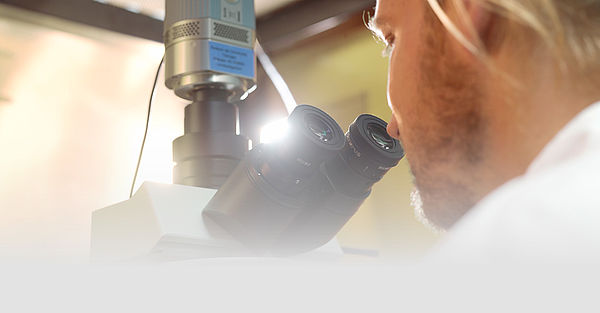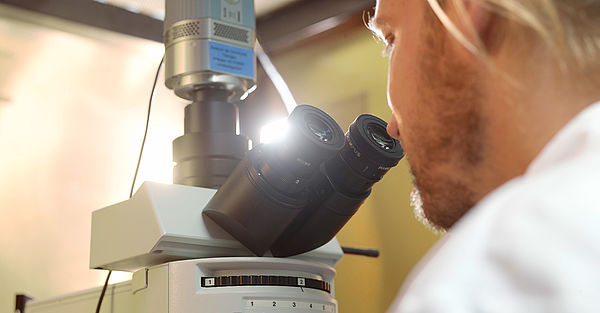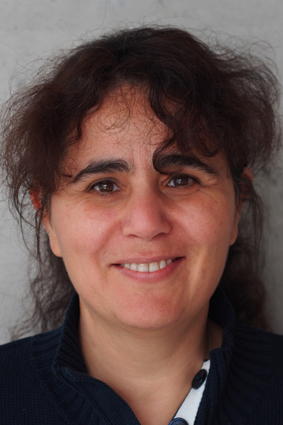

Associative coupling in the neocortex
The overarching goal of our work is to understand the operating principles of the neocortex, a unique brain structure, which mainly evolved in mammals. There is clear evidence that the neocortex, in the broadest sense, endows the subject with cognitive capabilities. The big mystery is, how the vast diversity of neocortex-dependent behaviors are generated by a structure that shows nearly identical neural architecture across species (mouse, rat, monkey, human) and functional systems (sensory, motor, cognition): The neocortex is a quasi-two dimensional sheet of neural tissue, which is composed of repetitive neuronal elements and network connections. Even an expert can hardly decide on the basis of a microscopic image of neocortex, whether it was prepared from a mouse, rat, monkey or human.
The generality of neuronal architecture related to vastly diverse functions renders it likely that, beyond specific signal processing, there must be a generic function common to all cortical areas in animals and humans. We hypothesize that the neocortex is a giant associative storage device, which handles flexible combinations of sensory, motor and cognitive functions that the individual is learning throughout his/her life.
To verify this hypothesis, we firstly need to clarify how signals are represented within neocortical networks and what role the confusing multitude of neuronal components plays (e. g. the six neocortical layers, or the various types of excitatory and inhibitory neurons). Second, it must be resolved how separate areas are linked and whether the link and concurrent signal processing make use of the same neural elements and activities, or whether they can be separated.
This research therefore requires the combination of a macroscopic and microscopic view – i. e. the study of representation of memories on the cellular level locally and their linkage between cortical areas globally. We employ an integrative approach using modern methods of multiple neuron electrophysiology and optical imaging and combine it with behavioral observation at highest precision. For that purpose we aim at highly quantitative analysis and representation of our results, reflected by cooperative work with computational neuroscientists. Our model of choice for studying these questions is the sensorimotor vibrissal system (vibrissae = whiskers) of rodents. These animals use an ‘active’ strategy of sampling tactile information about their immediate environment by actively moving their vibrissae across objects in their vicinity. We examine tactile representations, how they are formed into a percept, and how they are coupled to motor representations to optimize tactile exploration. We have begun to also study coupling of other areas, e. g. sensory and so-called higher cortical areas, during decision making. Finally, we have set up a learning paradigm, the so-called trace eye blink conditioning using whisker-related tactile signals as conditioned stimuli, to study how new learned contents is stored in cortical networks.
Regarding the close similarity of neocortex in animals and humans it is very likely that basic scientific knowledge that we gain in animals can be generalized very easily to understand also principles of function or dysfunction in humans and patients. Of course, future applications for the better of humans suffering from neocortical diseases such as Alzheimer’s and Parkinson’s disease, schizophrenia, or depression, need future progress in applied and translational neuroscience. However, before this can happen, a thorough understanding of the bases of neocortical function has to be reached. This is the purpose of our research.
Beyond the goal to understand the function of the neocortex we have started to direct our research toward possible future applications. We work toward the establishment of cortical sensory neuroprostheses, that in the future might help those patients, who lost a sense due to a disease of the central nervous system. A major problem is that percepts produced by electrical activation of cortical networks depend very much on the sensory and behavioral context. Our solution to this problem is to establish intelligent implants that measure neural activity to assess information about contexts (i. e. the associative state of the cortical tissue to be activated) and use this to increase precision with which sensory signals can be imprinted into central neuronal structures and reach perception.
Cellular mechanisms of cerebellar nuclei neurons function
Project leader: Dr. Christine Pedroarena
The basic cerebellar circuit is highly conserved along phylogeny, particularly amongst mammals. On the other hand the large increase in cerebellar size along phylogeny suggests that larger numbers of the same modules provide an increased cerebellar capacity to support the increased complexity of brain functions and expansion of other brain areas. Therefore, the investigations of the basic modular cerebellar circuits carried out in rodents provide useful insights about the human cerebellar function (or dysfunction). The most recognized function of the cerebellum is sensorimotor coordination and its adaptation to environmental changes. This role is illustrated by the severe incoordination of movements and impaired capacity to learn new motor tasks in most forms of cerebellar disease. More recently, a possible role of cerebellum in cognitive functions has been proposed, an idea supported by the involvement of cerebellum in cognitive deficits syndromes, such as autistic disorders.
Our research is focused on the neurons of the deep cerebellar nuclei (DCN). The axons of these cells provide the output pathways of cerebellum and thus are the signals of these cells that ultimately exert the cerebellar control on target structures. Deep cerebellar nuclei neurons are spared in many cerebellar diseases or their function is altered only secondarily to the alterations occurring at the cerebellar cortex. Hence, cerebellar nuclei are a natural place for compensatory mechanisms for diseases affecting the cerebellar cortex. We investigate the cellular mechanisms (synaptic and membrane properties) determining cerebellar nuclei neurons output and its plastic changes and how these might be affected by cerebellar disease, or can be modulated by external agents, with the goal to ultimately understand cerebellar function and provide rational basis for new therapies.
To this end we use in vitro electrophysiological patch recordings and microstimulation combined with optogenetics in brain slices taken from wild type or transgenic animals and immuno-histochemistry staining techniques.
The full list of publications can be found here: Schwarz Pedroarena Benali
Key publications
Hentschke, H., Haiss, F., Schwarz, C. (2006) Central signals rapidly switch tactile processing in rat barrel cortex during whisker movements. Cerebral Cortex 16:1142-1156.
Stüttgen M.C. and Schwarz C. (2008) Psychophysical and neurometric detection performance under stimulus uncertainty. Nat. Neurosci. 11:1091-1099
Gerdjikov, T.V., Bergner, C.G., Stüttgen, M.C., Waiblinger, C., Schwarz, C. (2010) Discrimination of vibrotactile stimuli in the rat whisker system - behavior and neurometrics. Neuron, 65:530-540
Waiblinger, C., Brugger, D., Schwarz C. (2015) Vibrotactile discrimination in the rat whisker system is based on neuronal coding of instantaneous kinematic cues. Cereb Cortex 25:1093–1106
Joachimsthaler, B., Brugger, D., Skodras, A., Schwarz, C. (2015) Spine loss in primary somatosensory cortex during trace eyeblink conditioning J Neurosci, 35:3772-3781
Schwarz LabChakrabarti S., Schwarz C. (2018) Cortical modulation of sensory flow during active touch in the rat whisker system. Nat. Commun. 9:3907.
Bhattacharjee A., Braun C., and Schwarz C. (2021). Humans use a temporally local code for vibrotactile perception. eNeuro 8:ENEURO.0263-21.2021.
Reviews
Schwarz C, Thier P (1999) Binding of signals relevant for action: towards a hypothesis of the functional role of the pontine nuclei. Trends Neurosci. 22: 443-451.
Feldmeyer, D., Brecht, M., Helmchen, F., Petersen, C.C.H., Poulet, J., Staiger, J., Luhmann, H., Schwarz C. (2013) Barrel cortex function. Progress in Neurobiology 103: 3–27
Schwarz C. (2016) The slip hypothesis: Tactile perception and its neuronal bases. Trends Neurosci 39:449–462. doi: 10.1016/j.tins.2016.04.008
Ongoing dissertation work
Bingshuo Li
Development of a complete method for in vivo electrophysiological investigation of transcranial magnetic stimulation in rodents
Prof. Dr. C. Schwarz / Prof. Dr. U. Ziemann
May Li Silva-Prieto
Changes in neuronal function and structure in the barrel column related to associative learning.
Prof. Dr. C. Schwarz
Kalpana Gupta
Influence of internally generated prediction signals on the ascending tactile pathway. A study in the vibrissal system of mice.
Prof. Dr. C. Schwarz
Yuechen Zhang
Neuronal bases of explicit memory studied using Pavlovian eyelid conditioning.
Prof. Dr. C. Schwarz
Ritu Roy Chowdhury
The role of the cerebello-parietal pathway in state estimation
Prof. Dr. C. Schwarz
Completed dissertations (since 2000)
Maysam Oladazimi (2019)
Biomechanical Texture Coding and Transmission of Texture Information in Rat Whiskers.
Prof. Dr. C. Schwarz
Julian Hofmann, (2017).
The role of mouse barrel cortex in tactile trace eye blink conditioning
Prof. Dr. C. Schwarz
Christian Waiblinger (2015)
The role of kinematic events in whisker-related tactile perception
Prof. Dr. C. Schwarz
Petya Georgieva (2014)
Active perception of virtual texture frequency in the whisker-related sensorimotor system of the rat
Prof. Dr. C. Schwarz
Bettina Joachimsthaler (2014)
Two photon imaging of structural plasticity underlying classical eyeblink conditioning in mouse barrel cortex
Prof. Dr. C. Schwarz
Caroline Bergner (2012)
Neuronal correlates of frequency discrimination in the tactile system
Prof. Dr. C. Schwarz
Isabella Schmeh, Dr. med. (MD, Medical School, 2012)
Gene expression of potential modulators of inhibitory neurotransmission in the Lurcher mutant mouse
Prof. Dr. C. Schwarz
Dominik Brugger (2009)
Adaptive microstimulation for stabilizing evoked cortical potentials
Prof. Dr. C. Schwarz
Florent Haiss (2007)
Contributions of motor areas to sensory processing during active and passive touch
Prof. Dr. C. Schwarz
Maik Stüttgen (2007)
Psychophysical channels and the physiology of perception in the rat whisker system
Betreuer Prof. Dr. C. Schwarz
Sergejus Butovas (2007)
Local synaptic effects of microstimulation in barrel cortex and pontine nuclei in the rat
Prof. Dr. C. Schwarz
Susanne Kamphausen (2006)
Functional architecture of the cerebellar nuclei: Investigations of membrane physiology, morphology, and glycinergic synaptic transmission of cerebellar nuclei neurons
Prof. Dr. C. Schwarz
Anja Horowski (2002)
Organization of tectopontine axon terminals with respect to the projections from visual and somatosensory cortices and dendritic fields of pontine projection neurons: Compartmentalization of rat pontine nuclei
Prof. Dr. P. Thier, Prof. Dr. C. Schwarz
Uwe Czubayko (2000)
A characterization of neuronal types in rat cerebellar nuclei using electrophysiological and morphological properties
Prof. Dr. P. Thier, Prof. Dr. C. Schwarz

Hertie Center of Neurology
Hertie Institute for Clinical Brain Research
Otfried-Müller-Straße 25
72076 Tübingen
Phone: +49 (0)7071 29-80462
Fax: +49 (0)7071 29-25011











